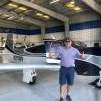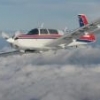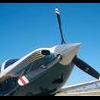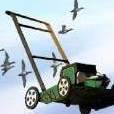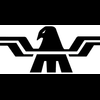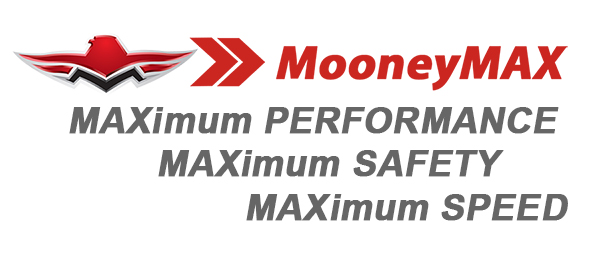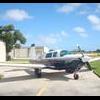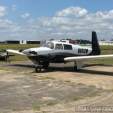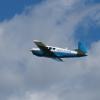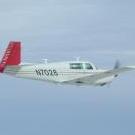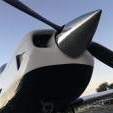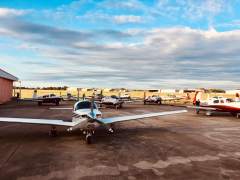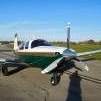Leaderboard
Popular Content
Showing content with the highest reputation on 04/05/2019 in all areas
-
And definition of “Hardest IFR”: Flying it IMC the whole time without a second pilot or an autopilot. Sent from my iPhone using Tapatalk Pro6 points
-
6 points
-
6 points
-
Ummmm….. Yes... Kinda not WHAT it tracks as HOW it tracks.. If you wish to read for a few... :) The TT has one ARINC 429 input and one RS232 input , both inputs use the same connections.. It listens to 232 data initially, but internally switches to ARINC if it is present. If the VOR is digital, the ILS is digital, your GPS is digital, the DG is digital, and your HSI is digital, - it will follow any of them as long as the ARINC 427 data sentence has the standard order. The TT (or any digital AP) does not know WHAT it is listening to, or cares, - it just points the aircraft where it is being told to.. Problem is, most of the above output steering instructions in our OLD aircraft are in the old ANALOGUE (++150Mv) format. Good in its time, but this format can send only ONE steering signal at a time. (Vertical or lateral) Any flags etc. have to have a separate wire for each flag or digit. (ARINC can send gobs of information in a single wire) So, if you have modern digital instruments outputting in ARINC data, the new breed of digital autopilots are happy. This is why some of us are excited about the coming TT integration with the Aspen and G5. With the aspen, it understands the "old" format, accepts (say your old analogue VOR) the signal, translates it to ARINC and sends it on to the TT which happily does what it is told. Your GPS Navigator outputs whatever you need by a menu selection. Mine will output the old format and several types of ARINC sentences. So the Aspen will accept this data in whatever format the instrument sends (even a radar altimeter) and acts as a "switch", selecting whatever instrument you want to follow, translates whatever information it is using, sends it on to the AP in ARINC format and everybody plays together. I suspect the Garmin G3X may do much the same thing. The Aspen will do this now. What we expect will happen (waiting game again, Aspen has some work to do, and this has to be approved by FAA) is you will be able to set the Baro , Alt, VS and heading on either equipment and it will synchronise to the other instrument. Most VFR functions will be set on the Aspen and the TT will follow along obediently. The TT head will be (mostly) relegated to an "On - Off" switch... Your GNS 430 will function as this source "switch" and enable the TT to follow your VOR and ILS or RNAV or whatever your 430 is tasked to do at the time. FWIW, I heard from one Cherokee driver who tested the 430WAAS and TT on an approach. It flew the aircraft through the entire approach, power changes, flap extensions (calling for trim) and it flew to the Rny centerline in a 7-10 knot crosswind until he "squeezed and flared" at 5 ft. alt. ("squeezing" refers to the CWS switch on the yoke, discoing the AP) Apologise for the long answer to a short question... but this may be helpful to some... :) Nav6 points
-
5 points
-
The G3X was appealing except for the GFC 500 additional cost. If Don Kaye’s quest continues the way it is, GFC 500 installs will be in the $20k+ range. Too rich for my blood. Especially since everything I have seen and read on the STEC 3100 puts it on par with the GFC 600. Sent from my iPad using Tapatalk Pro5 points
-
For me the main driver to order the MAX was losing AHRS with a pitot blockage with the old Aspens. Also note requiring a backup AI anymore is helpful (it's getting clearer that's what the certification will end with) . Some small enhancements such as timers come also with the MAX upgrade beside the things that mentioned before in the MS thread. The flight timer is triggering on the GPS airspeed off 30 knt. Also the chart page has a timer that can be used for timing the approach. I just changed the batteries in an old Evolutions 2000 system and the cost alone for that makes the step easy to the MAX. If you see the two displays in direct comparison (did this this yesterday at SNF again) it's a no brainer. Also the dimming for night flying of the MAX is better. I still found the older Aspens to still bright dimmed down as much as possible. What I dont like is the update process. Paying significantly in advanced and the shipping process of the old devices before the new one will be shipped out will ground the plane for several weeks. That's not very customer friendly.3 points
-
Hard IFR has always meant to me “total IMC”, as in you don’t see a thing. Not necessarily to mins. But when in total IMC for a while that’s “hard ifr”. Not because it’s hard as in difficult but because it’s total. Sent from my iPhone using Tapatalk3 points
-
3 points
-
This ongoing discussion is why it is important, especially with vintage Mooneys, for an owner to be deeply involved with the airplane and the IA that inspects it as well. When I did my annual I was totally impressed with the way it was done--and I am not talking about the stuff I did There is an incredible amount of leeway in the conduct and scope of the annual inspection--many owners do not realize this and I will proffer that as the source of a lot of post-annual unhappiness. The older your aircraft is, the more you should be involved (IMNSHO), but many others have said that as well. Frankly, some pilots fly around oblivious to the technicalities of their birds beyond what they see and must deal with during the pre-flight. That is all fine and good if you are a commercial pilot, or if your aircraft is near-new, the latter assumes that you are pretty much a high-roller and maintenance is done at the finest, and most expensive, shops.2 points
-
I wonder how much, if any, of the missing electrodes incidents have been at least partially due to mechanics treating fine wires the way they do massives. E.g., these plugs are not supposed to be subjected to aggressive bead blasting. I suspect cleaning and gaping plugs is a task that gets delegated... We're dealing with lingerie here not union suits.2 points
-
To me, hard IFR means being in the soup for continuous stretches and/or shooting approaches in IMC beyond the FAF. It is WAY WAY different in the clouds than under the foggles! The brain is very efficient at latching on to subtle visual references under the foggles to discern the correct spatial orientation in collaboration with the inner ear balance organs. In true absence of any visual reference in the clouds, signals from the balance system are radically misinterpreted by the brain. The two should never be equated.2 points
-
Shame about Packard, though. I'd still rather have a '56 Caribbean than a Tesla.2 points
-
2 points
-
June 6-9, 2019 Registration package - $295.00 each person Early registration $250.00 thru April 30th Registration package includes: All seminars and presentations Maintenance Clinic Right Seat Ready© - non-pilot companion Safety Seminar Mooney Zoom Speed Trials Thursday afternoon Homemade Ice Cream on site Mooney Mixer Cocktail Party Lunches: Thursday, Friday and Saturday Saturday Evening Banquet East Texas Regional Airport (KGGG) and Hilton Garden Inn and Event Center 905 East Hawkins Parkway - Longview, TX 75605 Events: MooneyMAX Maintenance Seminar (Friday & Saturday) - Don and Paul Maxwell and our staff Right Seat Ready© (Friday & Saturday) - Jan Maxwell and Jolie Lucas 2 days of seminars with top aviation professionals at the Hilton Garden Inn with lunch provided Mooney Zoom Speed Trial Competition - categories for all models Saturday - Continuation of Maintenance and hands on instruction Saturday - Continuation of Right Seat Ready© with tour of Control Tower and flight simulators Saturday - Airport Day - Lunch and Special Homemade Ice Cream Feast Mooney Zoom Speed Trials with lunch and special afternoon ice cream treat Transportation provided and rental cars available Saturday evening Gala Banquet at Hilton Garden Inn Hotel Reservations: Room rates: $119.00 (includes two cooked to order breakfast for two) For online reservations please click: Host Hotel: Hilton Garden Inn, Longview TX Line-up of special presenters: Mike Busch Specialties: High-profile aviation writer, speaker and teacher since 1970. Operation and maintenance of piston-powered general aviation airplanes. Well-known in aviation circles as founder of AVweb, and as a respected aviation writer and teacher for nearly 40 years. For the past 20 years, the primary focus of his writing and teaching has been aircraft maintenance. BA in mathematics from Dartmouth College, Magna Cum Laude, Phi Beta Kappa. At Dartmouth, did pioneering work in computer software development. Graduate studies in mathematics at Princeton, and graduate studies in business administration at Columbia. After retiring from a long and successful career as a software entrepreneur, co-founded AVweb (pioneering Internet aviation magazine and news service with 130,000 subscribers) in 1995. Served as its editor-in-chief and one of its most prolific writers for seven years until AVweb acquired by Belvoir Publications in 2002. Since 1970, published hundreds of articles in Air Facts, American Bonanza Society Magazine, AVweb, Cessna Pilots Association Magazine, Cirrus Pilot, EAA Sport Aviation, IFR, Light Plane Maintenance, and The Aviation Consumer. Co-founder of Aeromedix.com LLC, responsible almost single-handedly for the introduction of pulse oximeters and digital carbon monoxide detectors into GA cockpits. Since 2004 has taught 1000+ aircraft owners how to manage maintenance of their airplanes. More than 45 years in virtually all aspects of aircraft piston engine design, development, certification, installation and flight-testing. Bob Minnis A pilot since 1964, 7,500+ hours as PIC in piston GA airplanes. Commercial pilot with instrument, single- and multi-engine land, single-engine sea, and glider ratings; CFI for airplanes, instruments and multi-engine; and A&P mechanic with Inspection Authorization. FAA DERT - Engine and Powerplant Engineering – 1993 to present FAA DARF- Manufacturing – 1999 to present ODA Unit Member – 3S Engineering, Hartzell Propeller & Bombardier Minnis Aviation LLC - Owner, consulting engineering services firm providing technical, DER & DAR support. AvPower LLC - Principal Owner/Partner. Engineering services firm providing technical, DER & DAR Support and products to general aviation. PowerLite LLC - Principal Owner/Partner, Engineering Company dedicated to the development of STC’s. Aerospace Components LLC - Principal Owner/Partner, Engineering Company dedicated to the development of PMA’s. Teledyne Continental Motors - Mobile, Alabama Director of Installations , Director of engineering technical and customer support group for aircraft products, Vice President of Quality Control / Military , Vice President and General Manager of Teledyne Abbeville, General Manager of Teledyne Fixed Base Operation, Project Engineer, Supervisor of Mechanical Design , Associate Project , Engineer, Senior Designer Alfred "Lucky" Louque A part of General Aviation since 1967 and has been with Air Salvage of Dallas since 1974 Engine and accessory overhaul -- Major airframe repairs and alterations Engine test cell runs -- Accident Investigations and reconstruction Annual, 100 hr. and conformity inspections Credentials: Pilot single & multi engine land -- A&P Mechanic, IA (Inspection Authorization) -- DME (Designated Mechanic Examiner) -- DAR (Designated Airworthiness Representative) -- Amateur Built Original Issuance & Reassurance Airworthiness Certificates -- Import and Export (Complete aircraft, engine, props & components) -- Safety Counselor, Remedial Training Instructor -- IA Refresher Course Instructor -- FAAST Team Member Bob Kromer Forty-year career in General Aviation in Engineering Flight Test as well as serving in various management/leadership positions, including the Mooney factory. From 1983 – 1986, served as Mooney’s factory engineering test pilot performing development and certification work on M20J and M20K improvements. Served as the Flight test Pilot on the experimental, six-place, pressurized Mooney 301. From 1998-2001 served as MAPA’s Executive Director. Flown Mooneys for a total of 1500 hours – 1000 hours of factory flight testing plus 500 hours using Mooneys for personal transportation. Flown and evaluated all production Mooney models except for the single-place Mite, the M22 Mustang and the original wood-wing M20. Served as the primary Test Pilot for the complete Model M20K 252 FAA development and certification program. From 1986-1991 served as the Mooney factory Executive Vice President and General Manager, the top leadership position in Kerrville, Texas. Currently serving as Senior VP Engineering and Flight Test at Blackhawk Modifications in Waco, Texas, performing development and FAA certification flight testing on more powerful Pratt & Whitney turboprop engines installed in various models of King Airs and Cessna Caravan. Captain Mike Jesch Captain Mike Jesch has been flying for over 40 years and a Flight Instructor and airline pilot for over 30. Currently a senior Boeing 737 Captain for a major US airline, and owns and flies a Cessna 182 based in Southern California. Two-time Master CFI Two-time LGB District FAASTeam Rep Of the Year. Since the first airplane he ever got to maneuver as a young teenager was an M20J, he's had a special affinity for the Mooney series, and has flown many of them over the years, from the M18 Mite up to the M20R Ovation. Jimmy Garrison All American Aircraft Sales Integrity Aero All American Aircraft Sales is well known company in the Mooney world, specializing in the acquisition, sales and brokerage of all models of Mooney Aircraft since 1991. Currently, All American averages just under one Mooney sale per week. Jimmy Garrison is one of the top Mooney appraisers in the country and specializes in knowing exactly what your Mooney is worth and how to main it's value.In the 23 plus years since joining All American, Jimmy has over 750 Mooney sales. Integrity Aero, - over 100 additional sales of aircraft ranging from Cirrus, Twin Cessnas, Bonanzas and Turboprops including Meridians, TBMs, PC-12's and King Air 200's (Integrity specialized in Ram Upgraded 414's and King Air 200's). A 4000 hour pilot, Jimmy routinely flies about 150 hour per year, more than half as a part of All American and the balance as pleasure. He has about 3000 hours in Mooneys of all models. The rest of his time is comprised of single engine turboprop time (700+ Hours), 200 hours in twins and the rest is a smattering of trainers and off-model inventory that All American has taken on trade. Chuck "Cowboy" Crinnian Mooney Caravan, President CEO/CMO/Chief pilot at Frontier Aerospace Medicine FAA Senior Aviation Medical Examiner Hospital Based Neurology Clinical and organizational skills Aerospace/Aviation Medicine FAA Designated Aviation Medical Examiner Flight Physiology, Human Factors Flight Safety Red Star Pilots Association Flight Medicine/Flight Physiology Manager FAA FAAST Team Representative ATP, CFI-AIM, Phoenix, Arizona Area MooneyMAX Maintenance Clinic Don Maxwell Co-Owner and President Don Maxwell Aviation Services, Inc. Authorized Mooney Service Center Don Maxwell has 51 Years of Mooney flight experience. He began flying October 1966. 1972-73 Spartan School of Aeronautics, A&P License training A&P-IA, Commercial Pilot Single & Multi-engine Land, Single engine Sea, Instrument. 10,000+ hours. Have flown every certified Mooney Model from M10, M18, M20A, M20B, M20C, M20D, M20E, M20F, M20G, M20K, M20J, M20L, M20M, M20R, M20S, M20TN, M20V and M22 Mustang. MAPA Contributing editor A member of the United States Precision Flight Team competing in the World Precision Flight Competition, Denmark, 1989, and Argentine, 1990. April 1968 Started work at Houston Mooney, Houston Texas Mooney Distributor and Bellanca Dealer as a salesman Mooney Caravan pilot and sponsor Don "Paul" Maxwell, II Co-Owner, Vice President and General Manager Don Maxwell Aviation Services, Inc. Authorized Mooney Service Center Paul Maxwell began his life in aviation at the age of 6 weeks while flying with his mother and father. Growing up in-and-around Mooneys his life, Paul was flying left-seat at age of 10 and soloed at 16. During his first 4 years in the U.S. Army, he was away from aviation and in the Signal Corp, but the following 4 years he returned to aviation as a UAV Pilot. In 2008 after his service time in the Army, Paul was hired by Northrop Grumman as pilot, test pilot, instructor, and site leader for the Northrop Grumman Hunter UAV for 8 years. After 16 years away from General Aviation, Paul returned home to the family business, Don Maxwell Aviation Services Inc., at the position of Vice President and General Manager. Definitely comes from a Mooney family. Right Seat Ready - clinic for non-pilots - Advanced RSR - for those who have taken the seminar and want to build skills Jolie Lucas Jolie Lucas is a Mooney Owner, Licensed Psychotherapist, Educator, Aviation Writer, and Instrument Pilot. She has taught Right Seat Ready! for a decade with her partner Jan Maxwell. Her current presentation series is Exit the Holding Pattern: Achieve your Goals. Come see Jolie at Sun n Fun in Lakeland, Florida on Thursday April 3rd or Friday April 5th at 11:00 a.m at the SNF educational forums, or at the AOPA Pavilion, Saturday April 6th at 2:00 p.m. Jan Maxwell Jan Maxwell has been an Instrument Pilot and Mooney owner since 1980. Precision Flight Judge appointed by Fédération Aéronautique Internationale, FAI, representing the U.S. at the World Precision Flight Competition in Denmark, 1988, and Poland,1992. Member of Ninety-Nines, Inc. and National Chief Judge for National Intercollegiate Flying Association (NIFA) in 1992. She is co-owner of the family business, Don Maxwell Aviation Services, Inc., an authorized factory Service Center, in Longview, Texas. Jan created Right Seat Ready in 2005 primarily for the Mooney community and later joined with Jolie Lucas to take the program across the country and all General Aircraft.2 points
-
Outbound flights from mainland USA to PR or USVI doesn’t require a clearance, at least from the CBP training I received several years ago. Departing PR or USVI to mainland USA does indeed require customs. It may sound ridiculous but it is necessary due to zero border defence on those islands from people just showing up in a raft (happens all the time). Sent from my iPhone using Tapatalk2 points
-
If they aren't identified on the diagram, you don't need to remove them. I printed the diagram out, colored in the panels to be removed and then laminated it. The diagram also tells you what you are looking for and if you need to lube.2 points
-
This year’s Sun n Fun exhibition hangars were full of Avionics innovation. Crowds huddled close to bright displays. Just not in the King booth. Last year I went to get a new car but the Packard and Hudson dealers had closed. So we got a Tesla.2 points
-
Looked at the G3x today at SnF. My brother in law was getting ready to buy a GTN750 but now is debating whether the G3x with a Garmin 175 is a better option. The G3x would provide even larger screen than the 750 and the Garmin 175 would feed the GPS navigation to the G3x Sent from my iPhone using Tapatalk2 points
-
It doesn't seem like a lynch mob is in the works. There was certainly some "over promise under deliver" that happened so I can see where the disappointment is coming from. The reasons why aren't really important. The STEC I've been flying behind still works fine so I'm somewhat unaffected by the news. The disappointment on my part was that I allowed myself to believe TT was closer than they actually were to getting things done. TT delivering a solid product in a timely fashion would have been good for the AP market as a whole.2 points
-
I'm all in on this MAX upgrade and have also purchased an MFD to go with it. For about the first three days after Garmin announced the G3X, I was rethinking this plan and could have backed out and gone Garmin. But after talking with Garmin, sitting through their webinar, reading everything over on Beachtalk, I'm convinced the G3X would be a step back in real capability in exchange for a larger screen. And in my Mooney cockpit with the panel only 12" from my face, the large screen isn't an improvement. MAX Pros for me: Warrantee (I had bought a used PFD with no warrantee) No standby AI requirement (can remove all round gauges, clean panel) Upgrade pricing (I wanted to be early on the upgrade list and not wait for OSH 2020 for the next special pricing) I was able to buy a refurbished MFD and then apply the MAX upgrade. Along with my Barnstormers special PFD, the MAX upgrade effectively turns a used PFD/MFD combo of dubious origins into new equipment with new warrantees. The G3X route would have required a GFC500 autopilot to replicate what I have now. That's expensive and not even available as of today. I already have ADSB, and an IFD540, neither would have worked with the G3X.2 points
-
+1 on caruso's post. and +1 on Don's post. Any Mooney will treat you well. The e, which I have had for 20+ years, is a perfect retirement cross country or countryside cruiser. Low and slow or high and fast. It does both economically and with style. Compared to brand B, parts and maintenance are 1/2 at least. Al mooney did us all a great service with his 20th design. Wonderfully smooth push rod controls, economical and reliable manual gear and flaps, a bullet proof lycoming, many say is the most reliable GA aircraft engine ever produced...Its hard to find a shortcoming. If 10 knots extra means that much to you then there is always the luxurious and beautiful Bo at a higher capx and opx.2 points
-
2 points
-
1 point
-
Well... the 10" that differentiates the C & E from the F & J is split between the back seat leg room and the baggage area. The front seat room of all those models are the same. Other than that little confusion, there's a lot a great comments above. @carusoam mentioned my retirement plane. I starting flying in a E model 50 years ago and owned another one for a long time when I was working - back in the '70s/'80s. Then I didn't fly for more than 20 years. At age 68 I bought another "Super 21" thinking I might be lucky enough to fly another 5 years. Now 76, I'm on a second 5 year plan and expect to log about 100 hours in '19. From NC we've done a MAPA PPP at Lakeland, Red Sox Spring Training in Ft. Myers, Sun 'n Fun in Lakeland as well as shorter trips to Edenton NC. etc. Still on the docket is MooneyMax in Longview, some Mooney Caravan formation flying before picking up a grandson in MA and sharing AirVenture with him. You will want to get that instrument ticket. The training will make you a much safer pilot even if your retirement status means you don't have to launch into serious weather. Great avionics are available for our old airframes... in fact a 10 or 15 year old plane probably will have a panel inferior to what's in my '66E and certainly won't compare to Don Kaye's M20M. Happy hunting!1 point
-
In 1987 I was working in Oakland when Coppola was filming scenes for his movie in front of my office building. They were there for about three days and all day long I would hear their helicopter engines rev up. What most people don't know about the film is that only four or five of the cars were actual real Tucker's, the rest were props made out of a fiberglass shell and bolted to a frame with wheels.1 point
-
And let’s not forget about the Tucker Torpedo! A man and his car ahead of their time. Sent from my iPad using Tapatalk Pro1 point
-
I should pull mine and send it to China and have 5,000 made for $0.25/ea Sent from my iPhone using Tapatalk1 point
-
Yes, and a very nice lady! She, her son and her husband go out of their way to make you feel at home whenever you are there. By the way, they do some pretty good work on Mooney’s too.1 point
-
Good morning. Flight was at FL17 - just shy of 4.5 hours LOP - landed with 17 gallons. TAS of @205. BOHLKE in StX has fuel at $6+ so added only 20 gallons, flew to st thomas the next day at st thomas jet center where fuel was $4+, so topped off. Customs to leave was confusing so filed eapis and went to TJIG and did customs there in less than :05. Headed back this weekend. Sent from my iPad using Tapatalk1 point
-
Any chance that @jaylw314 might be the FAA employee I was asking about? I can understand equipped, but not functional ADSB, aircraft getting a one time exemption (like for a trip to the avionics shop) but aircraft without ADSB installations being allowed inside the mode c while others played the FAA game of compliance is what’s questionable to me. I’ve somewhat been following this as modern ADSB equipment really doesn’t have a place in antique aircraft panels. While many pilots (1960’s up Mooney, Beech, Piper, Cessna, etc) are just biting the bullet and convincing themselves this is a good time to upgrade their panels, most antique aircraft owners cringe with the thought of digital displays in the cockpit. I’d give one time exemptions a try on my other ‘non-adsb’ aircraft and see how it works out before I’ll spend $3500+ on equipment for an occasional evening flyer. I’m at 28 miles out on the 30 mile mode c, the Culver rarely stays in the ring as most flights are heading south outside the mode c and nowhere near the class B 6,000’ floor (the tires haven’t even touched pavement in probably 100 landings). And from what I’m hearing on the board here with verification flights, and experiencing myself flying the Mooney, it’s questionable if ATC can even see ADSB aircraft for a substantial portion of the actual flight inside mode c veil anyways; What are we equipping for? To appear on an iPad for other low-n-slow bug smashers? The ADSB fun is really just beginning, the enforcement stories after Jan 1st should be entertaining!1 point
-
This has been written into the CFR's from the beginning, so it should not be a surprise. From 91.225: (g) Requests for ATC authorized deviations from the requirements of this section must be made to the ATC facility having jurisdiction over the concerned airspace within the time periods specified as follows: (1) For operation of an aircraft with an inoperative ADS-B Out, to the airport of ultimate destination, including any intermediate stops, or to proceed to a place where suitable repairs can be made or both, the request may be made at any time. (2) For operation of an aircraft that is not equipped with ADS-B Out, the request must be made at least 1 hour before the proposed operation. I suspect now that 2020 is around the corner, people are just starting to talk about how this would actually work. Why would this be upsetting to anybody?1 point
-
I had a Tempest fine wire plug lose its center electrode a couple of weeks ago. I initially noticed it only as higher than normal EGT on one cylinder during cruise, but a mag check once on the ground showed the engine running incredibly rough on the right magneto. That narrowed things down. I had a mechanic pull the spark plug in question and we were shocked to discover the center electrode missing. We replaced the plug with a Champion fine wire plug because that's what they had available. Interesting to hear that this seems to be a somewhat common failure mode for the Tempest fine wire spark plugs.1 point
-
LOP v. ROP... Flaps v. no flaps on T/O... Where to mount an iPad v. Where to mount a second iPad... Lap board style, yoke mount, or attached to the airframe in various locations... or temporary mount in the panel.... or attach and use like the visor...? This question is the most susceptible to personal preference... you may want to search through a few threads to see what is being used by everyone... Best regards, -a-1 point
-
I should clarify. When I said I only had to re-do 3 of the 9 rivets, I meant that I replaced all 9, but I botched 3 of the replacements, and had to drill them out and start over. So I actually placed 12 rivets total. In addition to the rubber seal, the ram air door consists of three pieces of metal: two flat "sandwich" plates, and a third dimensional piece of metal which captures the actuator plate. RLCarter is correct that you have to drive an initial set of 3 rivets to fasten just the two the "sandwich" plates around the rubber seal, then the final 6 rivets go through all three pieces of metal.1 point
-
If you find duct tape. Spend a day replacing it with aluminum tape. Old duct tape will hold water. Ask your IA what panels he would like removed You can inspect the whole wing if you remove 3 per side. Also rearmost under wing panel near the wing root. Strip of alum on the tail joint. One side should be good. Lube jack screw and inspect. Battery access cover on port side.1 point
-
No, the AXP340 is a transponder that Trig makes for Avidyne. The AMX240 is an audio panel by PS Engineering, made for Avidyne.1 point
-
Got back from S&F late last night. I know Mooney took some (justified?) flak last summer during S&F and osh. I have to say I really enjoyed my time stopping by the display yesterday. Some very knowledgeable people were there with decades of experience. Very welcoming and helpful not closed off and preoccupied that I sensed before. Thanks Mooney for the appropriate changes!1 point
-
Could be. Matt? (from the summit) was actively showing the Ovation off to a few parties. I talked with Paul (knows everything electrical for Mooney aircraft) for a long time and he was very helpful. Everyone when I was there were engaging potential customers. No cellphone or texting BS. No fence BS. Refreshments offered to anyone that showed interest/walked by. It might be a consistency problem during the long shows?1 point
-
I recall getting an old CB my uncle had given my brother and I. We got the thing working and started making calls like we had seen in the movies. Some truckers in I-95 weren’t too appreciative and gave us some lessons in colorful language.1 point
-
In the past, I have always gone with the WiFi only iPad and it has worked fine. In a normal enviornment, my panel provides Flight Plan, GPS, and ADS-B info to my iPad. I always thought to myself, why would I need the GPS/Cellular version of the iPad in the cockpit. Then, this past summer my backup alternator broke at Oshkosh... no biggie, it was the backup anyway. I flew it back home and setup a time with my maintenance shop once I got back. On the day I took my plane into maintenance, I noticed on climb-out that my primary Alternator was now annunicating and I was in-fact on battery power. Primary Alternator had failed in the climb. I chose to continue the flight as it was a perfect VFR day and I was already at cruise altitude enroute when I had diagnosed the issue. I pulled the battery breaker to save battery power because I would be flying into a Delta Airspace (towered) airport. I pulled out my portable handheld radio and monitored Center. My WiFi only iPad was of no use for GPS execpt for digital cached maps (dead-reckoning) and Charts - no Location/GPS even though I was tethered to my phone. I pulled out my phone and had full GPS signal but no Cellular... I was at 12,500ft. I was able to power the plane back up on battery before entering the TSRA and Class Delta to get my clearance to land, flaps, and gear with plenty to spare. I used the phone for cross-checking my route but decided to use my early PPL training (VFR maps, compass, and clock) to finish the flight as primary source of navigation. From that moment on, I decided the extra ($130) money was nothing to have another device with a GPS in the cockpit with me at all times. I did, however, wait until the latest (iPad 5 Mini) came out for the full version.1 point
-
1 point
-
Whenever I lean on the ground, I increase the throttle to 1200 RPM (what I typically use to start moving during taxi), and lean until it starts decreasing. That way, I know that if I forget the mixture during takeoff, the engine won't go past 1200 RPM. All that will happen is embarrassment1 point
-
I think his oil consumption issue is related directly to his practice of doing touch n gos. [emoji1787] Sent from my iPad using Tapatalk Pro1 point
-
This whole conversation is silly. It has nothing to do with ROP/LOP. The OP has a broken piston or ring. It happens some time.1 point
-
A bit of a straw man, I think. The OP says nothing of limiting power to 75%, nor does he mention 100 ROP only above 7500. Taking only the information the OP provided at face value, he uses 100 ROP in all flight regimes without regard to MP or density altitude.1 point
-
1 point
-
1 point
-
As I understand it, you're putting a new or newly overhauled engine on this airplane? The M20K 231 variants are known to be hard on engines. Turbo's are hard on engines. And the 231 requires more manual engine management than any of the turbo versions. Finally, as you already know, the engine is the most expensive piece of your airplane. Therefore it only makes sense to protect that investment. And in my opinion, the best way to protect your engine is to have a reliable and accurate, data logging, engine monitor. And of course, know how to read it and use it. The EDM-900 is the cheapest way to bring all of your engine instrumentation into the modern era at one time. The EI CGR-30P is another good option but without the fuel gauges. I'm convinced that having an EDM-900 in my M20K 252 has allowed me to manage my engine to 1500 hours on all original cylinders. At the same time I get better range on account of accurate LOP operations and perfectly accurate fuel data. Longer flights with fewer take offs and landings contributes to the longer life of all components from airframe to engine to turbo. The EDM-900 also saves hours of maintenance by easily and accurately diagnosing engine issues without hours of troubleshooting and needlessly purchased parts. Finally, the EDM-900 can be installed without recutting your panel. It will slot into a standard 3.5" hole with a little overhang to the side or top. It can be oriented either horizontal or vertical. I can't think of any optional purchase more useful, valuable, or beneficial than a good engine monitor. And that goes double if you fly a turbo. Of all the instruments/gauges in my panel, the engine monitor gets the bulk of my attention during flight. And second place isn't even close.1 point
-
José, I cannot find any authoritative studies confirming your (personal anecdotal) experience. The fine wires seem to have design advantages irrespective of the well documented here QC advantage of Tempest vs. Champion in recent years. This appears to be an older analysis but it includes confirmation of @jetdriven's comments. http://www.ramaircraft.com/Maintenance-Tips/Spark Plugs-Fine-Wire-vs-Massive.htm1 point



